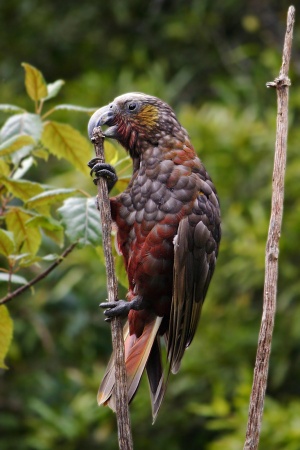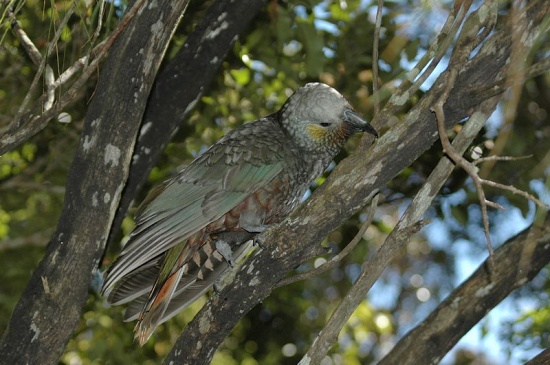(Pictures of north island brd and south island in flight.. Some deleted text replaced, some copied text disguised. References) |
|||
| Line 43: | Line 43: | ||
==External Links== | ==External Links== | ||
{{GSearch|Nestor+meridionalis}} | {{GSearch|Nestor+meridionalis}} | ||
| − | + | ||
[[Category:Birds]] [[Category:Nestor]][[Category:Bird Songs]] | [[Category:Birds]] [[Category:Nestor]][[Category:Bird Songs]] | ||
Revision as of 21:49, 12 February 2017
- Nestor meridionalis
Identification
45 cm (about 17¾ins) 475-525gms (about 1-1.15 lbs)
A large parrot, with crimson rump and underwings.
Variations

Photo by PatrickE
Mt Bruce National Wildlife Centre, North Island, New Zealand, February 2010
The North Island birds are olive brown with darker feather edges: the crown is lighter and greyer; collar, lower belly and undertail are crimson; golden wash on cheeks. The male has a longer and more arched bill. The juvenile has a yellow base to the lower manidble.
The Kakas of South and Stewart Islands are brighter in colour, with an almost white crown. The Kaka is around the same size as an Umbrella Cockatoo or about 10cm larger than a Galah or Major Mitchell's Cockatoo.
Similar Species
As with its cousin the Kea, the hen Kaka closely resembles the cock but with a somewhat shorter and less curved beak.
Distribution
New Zealand : a large, sometimes inquisitive parrot of the forests, a locally common New Zealand endemic.
Taxonomy
Subspecies
There are two recognized subspecies[1]
- N. m. septentrionalis:
- New Zealand (North Island and adjacent offshore islands)
- N. m. meridionalis:
- South Island, Stewart Island and larger New Zealand offshore islands
Habitat
They are now only to be found in what remains of lowland and mid-altitude forests.
Behaviour
Diet
Their main diet consiss of fruit, berries and seeds. They have a bristle tongue which enables them to add nectar to their diet. They also eat insects. A major source of energy comes from honeydew, produced by a small beetle living in the bark of beech trees.
Breeding
They use a large tree hollow for their nests. The breeding season runs from September to April.
Vocalisation
They are noisy birds, having a variety of calls, from a harsh grating to liquid whistling notes.
<flashmp3>Kaka Ackers Point.mp3</flashmp3>
Listen in an external program
Recorded by Andrew Whitehouse
References
- Clements, J. F., T. S. Schulenberg, M. J. Iliff, D. Roberson, T. A. Fredericks, B. L. Sullivan, and C. L. Wood. 2016. The eBird/Clements checklist of birds of the world: v2016, with updates to August 2016. Downloaded from http://www.birds.cornell.edu/clementschecklist/download/
- Handbook of the Birds of the World Alive (retrieved January 2017)
- TrekNature
Recommended Citation
- BirdForum Opus contributors. (2024) New Zealand Kaka. In: BirdForum, the forum for wild birds and birding. Retrieved 27 April 2024 from https://www.birdforum.net/opus/New_Zealand_Kaka





